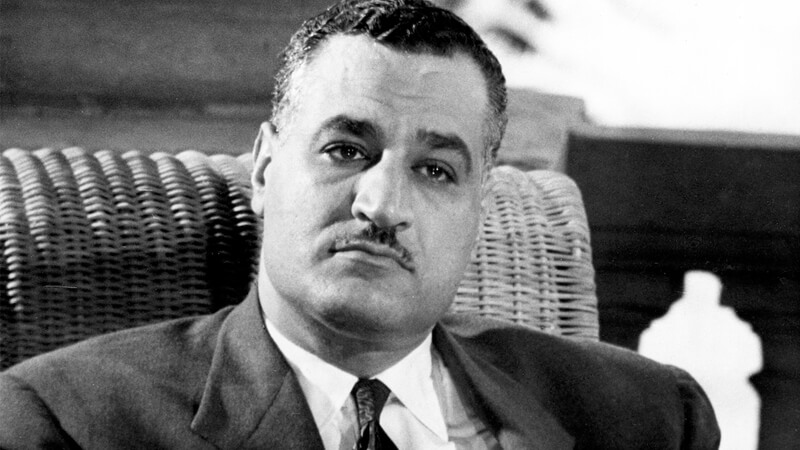Biography of Gamal Abdel Nasser: – Political and military Egyptian, president of the Egyptian republic between 1954 and 1970. Son of a postal officer attended primary school in al-Khatatibah, a village in the Nile delta the one that had been destined.
He continued his studies in Cairo and participated in frequent anti-British and anti-monarchist demonstrations, which led to his first admission to prison at age 17 accused of conspiracy.
After secondary education and a brief stay in a law school, in 1937 he was allowed to enter the Royal Military Academy cairota and three years later he graduated as second lieutenant.
Biography of Gamal Abdel Nasser
- Born:- 15 January 1918, Bakos, Egypt
- Died:- 28 September 1970, Cairo, Egypt
- Battles/wars:- 1948 Arab–Israeli War
- Years of service:- 1938–1952
- Spouse:- Tahia Kazem (m. 1944–1970)
- Children:- Khalid Abdel Nasser, Hoda Abdel Nasser
- Books: Egypt’s Liberation: The Philosophy of the Revolution, The Historic Letters Between Kennedy and Nasser
In 1948 he fought in the war against Israel before being taken prisoner and later served in Sudan, then under Anglo-Egyptian condominium. Nasser, then commander, made contact with other young officers, equally unhappy with the defeat of the Arab armies against the small Jewish state and the incompetence and corruption of the reigning monarch and in 1949 formed the clandestine revolutionary organization of the Free Officers.
See Also: Biography of Lal Bahadur Shastri
Nasser and his companions, inspired by a strong Arab nationalism and the methods of political action of the Muslim Brothers, matured their conspiracy to overthrow the regime of King Faruk.
On the night of July 22, 1952, the Free Officers Committee successfully led a bloodless coup that would inaugurate a cycle of revolutions of a similar kind in the Arab world.
Nasser, now with the rank of colonel, assumed the leadership of the Revolutionary Council and the command of the Armed Forces, while General Muhammad Naguib, nominally the leader of the movement, took command of the Government (since 1953 also the presidency of the new Republic).
On July 18, 1953, coinciding with the abolition of the monarchy, Nasser was appointed deputy prime minister and minister of the Interior, positions from which he revealed to the observers his condition of strong man of the new regime.
The struggle between Naguib, a moderate in favor of the agreement with the Western countries and to recover liberal sectors of the monarchy, and Nasser, in favor of initiating a pan-Arab nationalist movement against Israel and adopting the neutralism against the superpowers, was in favor of secondly, that on February 25, 1954 he took over the leadership of the Government and on November 14 he definitively deposed Naguib and assumed the presidency of the Republic. Days ago, on October 29,
On June 23, 1956 Nasser submitted to a popular referendum a constitutional bill that made Egypt a single-party Arab Socialist Republic, the National Union (created by decree on May 28, 1957) strong presidentialist system and with Islam as a religion official.
He, moreover, presented himself to presidential elections, in fact a plebiscite as his candidacy was the only one allowed. The Egyptian people voted favorably in both consultations with virtually 100% of the votes.
The foreign policy of the new Nasserist Egypt took a radical turn. On February 5, 1955, the Yugoslav leader Tito received him in Brioni to explain his proposal for a third world bloc of non-aligned countries.
Nasser was one of the most outstanding participants of the celebrated Bandung Conference (18-24 April 1955 ) and on July 17-21, 1956 he again met Tito in Brioni together with Indian Prime Minister J. Nehru; was thus defined the trio of great leaders of the Third World until the mid-sixties.
Nasser’s great dream was to unite the divided Arab peoples under the Egyptian leadership to fight the irreconcilable enemy, Israel, and achieve the true independence of Egypt, both in the political and economic realm, actually lost since the Persian invasions they demolished the last pharaoh 2,500 years ago.
Nasser developed the agrarian reform (put in place 8 of September of 1952) and submitted the economic activity to the State. Nasser personally led negotiations with the United Kingdom for the withdrawal of his troops from the Suez Canal, concluded by agreement on 19 October 1954.
Pillar of the development projects was the great Aswan Dam, in the first Nile waterfall, in order to produce the electricity required by those and win desert for cultivation. At first he addressed the World Bank, USA, and the UK in search of funding.
The talks began on 17 October 1955 with Washington’s discontent, for on 27 September Nasser acknowledged that the USSR and Czechoslovakia had agreed to supply him with war material, a fact of great significance, since it broke the West’s arms monopoly in the Middle East.
On 20 July 1956 the US government canceled its offer of aid on the grounds that the Egyptian leader had included the Soviets in the company, a decision that the British government seconded the following day.
Nasser’s response to the Western boycott was spectacular and triggered an international earthquake: on July 26 he announced in a speech in Alexandria the nationalization of the Canal and the continuation of the Aswan project without the funds requested.
Nasser wanted to put pressure on the West as the means to obtain the financing of the dam and in step gained the enthusiastic adhesion of the Arab masses, becoming the champion of the emerging Third World.
But its bold bet had very serious economic and strategic implications for the United Kingdom and France, the main shareholders of the Canal.
Alarmed, the British and French governments secretly negotiated with the Israeli (interested in ending the Suez closure of its ships, in force since 1949, and the most recent Gulf of Akaba, the departure to the Red Sea since September of 1955) the organization of a joint attack against Egypt to get rid of Nasser, its common enemy.
The military plot was decided at a conference in Sêvres on 22-24 October. The plan stated that Israel would invade Sinai; military operations would jeopardize the security of the Canal, whereby London and Paris urged Israel and Egypt to put an end to hostilities; Israel accepted and Egypt, presumably not, offering the pretext for the Franco-British intervention directed to occupy the Channel.
The Israeli offensive began on October 29 with a surprise attack that made great progress in Sinai and penetrated to the vicinity of the Channel at the height of Ismailia.
On 30 London and Paris presented their ultimatum, Egypt rejected it and the following day the allies began to bomb the Egyptian aerodromes and sent paratroopers to Port Said and Ismailía, to which Suez was added 5 of November.
Nasser had no chance of militarily defeating his attackers but international outrage and joint US pressure. And the USSR for the cessation of intervention played in their favor. The UN demanded the Allied withdrawal and recognized Egyptian sovereignty over the Channel, on November 6 a ceasefire was reached and on December 22, the Franco-British expeditionary body was re-embarked.
Nasser completed his victory the following year with the Israeli withdrawal from Sinai, after obtaining the Jewish government (March 29, 1957) the lifting of the naval blockades of Suez and Akaba.
The years immediately following the Suez crisis marked the heyday of Nasserist Egypt and the strengthening of collaboration with the USSR. Political forces and military movements took the pan-Arabist and socialist discourse of rais in other countries of the region.
On 1 February 1958 Nasser and his Syrian counterpart Shukri al-Kuwatli announced in Cairo the union of the two countries in a single state that took the name of the United Arab Republic (RAU), to which Yemen added on March 2.
However, Syria soon became dissatisfied with Egyptian centralism and the authoritarianism of the executive presided over by Nasser, and on September 28, 1961, a military coup in Damascus led to the separation of the country. Nasser did not oppose the fact and kept the name of RAU for Egypt.
In 1958 it realized a triumphant tour of three weeks by the USSR and in the Red Square of Moscow magazine reviewed with N. Kruschev to the parade of the First of May. In 1964 it received the greater decoration of the USSR, Hero of the Soviet Union that never before was granted to a foreigner.
Although the honeymoon with Moscow was not freed from serious friction, by the persecution of communists during the union with Syria, the denunciation of the Iraqi Communists and the absorption of the Egyptian PC by the official party in 1965, the fact is that Egypt received 43 percent of all Soviet aid to the Third World between 1954 and 1971.
Soviet leaders also understood that, like other Third World leaders, Nasser was ideologically insufferable and the treatment of him should be more respectful than that applied to communist regimes of Eastern Europe.
At the beginning of the sixties Nasser accentuated state and socializing dirigisme of the economy, extended the nationalizations to the banks and the national insurance companies (the French and British firms had been the 15 of January of 1957), the shipyards and various industrial enterprises (July 1961) and decreed a second agrarian reform (1962).
Its internal power, which nobody dared to answer for the effectiveness of the police methods, was consolidated with the presentation, on March 21, 1962, of a National Charter replacing the National Union by the Arab Socialist Union (USA, formally constituted 24 September 1962) as a single party and defined the socialist principles of the Republic. On March 15, 1965, his presidency was again plebiscited at the polls.
Despite the setbacks of his pan-Arab project, Nasser had not lost an iota of his enormous prestige in the Arab world. Cairo and Alexandria was the scene of numerous conferences of statesmen who took stock of developments in the Arab union and designed strategies for action against Israel.
In 1964, the Palestine Liberation Organization (PLO) set up its first headquarters in Cairo, and until the arrival of Y. Arafat in 1969, Nasser maintained important control and influence over a movement he considered instrumental in the struggle against Israel and did not want to lose sight of its particular, often radical, nationalism.
On the other hand, on May 13, 1964, it achieved great propaganda success with the inauguration of the Soviet-built Aswan Dam, which entered service in 1968.
Nasser’s growing Israeli warmongering against Israel, a victim of his own rhetoric and heroic image he had created for himself, reached a point of no return in 1967. Repeating the 1956 escalation, on 17 May he demanded that the UN withdraw the UNEF blue helmets – which had been interposed between the two armies in Sinai and Gaza since 1957 – closed Akaba to Israeli navigation, deployed troops on the border and fortified the defenses of Sharm El Sheikh, at the southern tip of the peninsula.
Sinai, opposite the Strait of Tiran and the exit to the Red Sea. Badly informed by the Soviets, Nasser established a military alliance with Syria and Jordan and redoubled his threats.
Believing the imminence of an attack, on June 5, Israel launched a formidable offensive that in the first hours annihilated Egyptian aviation at its aerodromes and trampled the land defenses of the Sinai.
On day 8 the Israeli units completed the occupation of the peninsula and reached the Channel by three points, Port Said, Ismailia and Suez. In four days of fighting the Egyptian army had been disrupted with a balance of 11,000 dead soldiers, 5,600 prisoners, 1,000 transport vehicles and 700 destroyed tanks, and 70,000 tons of ammunition and equipment lost. The best Egyptian troops -40,000 men – fought in Yemen and could not make it in time.
Nasser, who had always insisted that he would not enter into another war with Israel until the conditions of Arab military superiority and unity and diplomatic isolation of the Jewish state were given, first accused the United States of America.
To participate in the bombing (which was not true), so broke the diplomatic relations and closed the Channel to all navigation. But on day 9, overwhelmed by the disaster, publicly accepted his responsibilities and put his position at the disposal of the country, which was not accepted by the Parliament and the population, which again acclaimed him in mass demonstrations. After the defeat in the Six Day War Nasser would no longer be the same.
In the last years of his life Nasser adopted a more realistic attitude towards Israel, despite inflammatory statements about the reconquest of the occupied territories and the continuation of sporadic clashes of greater or lesser gravity, within the strange “war of attrition “which would continue until the fourth conflagration in 1973.
On July 17, 1970, he accepted the US Rogers Plan, which established a commitment to accept UN Security Council Resolution 242, a ceasefire in the Canal during 90 days and its eventual demilitarization in a strip of 20 km, as well as its reopening to the naval traffic. Nasser had met on his trip to Moscow the previous June 29 with which the Soviets conditioned the delivery of arms to the acceptance of the plan.
Nasser’s last service to the Arab nation was his mediation in the Jordanian Black September, the bloody civil war between the Hashemite army and the Palestine Fatahin of the PLO. On September 27, 1970, in Cairo, King Hussein and Arafat signed a cessation of hostilities, but despite his broad smile during the act, a gesture that always accompanied his exuberant personality and imposing physique, Nasser was exhausted.
The next day, September 28, a heart attack ended his life. On October 1, five million Egyptians paid homage to their missing leader, mourning scenes that were held in many countries in the Middle East, Africa and the Islamic world in general.




